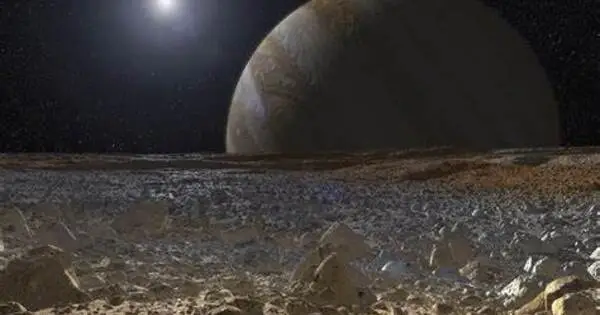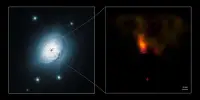Europa is thought to have a deep ocean beneath its icy cover, and scientists have been particularly interested in this moon due to the possibility of life there. Astronomers studying data from NASA’s James Webb Space Telescope discovered carbon dioxide in a specific location on Europa’s frozen surface.
Europa, Jupiter’s moon, is one of a few places in our solar system that could potentially support life. Previous study has revealed that beneath its water-ice layer lies a salty ocean of liquid water with a rocky seafloor. However, planetary scientists had not determined whether that ocean had the ingredients required for life, particularly carbon.
Using data from NASA’s James Webb Space Telescope, astronomers discovered carbon dioxide in a specific location on Europa’s frozen surface. According to the analysis, this carbon originated in the underlying ocean and was not delivered by meteorites or other external sources. It was also deposited on a geologically recent timescale. This discovery has significant ramifications for Europa’s ocean’s potential habitability.
Scientists are debating how much Europa’s ocean connects to its surface. I think that question has been a big driver of Europa exploration. This suggests that we may be able to learn some basic things about the ocean’s composition even before we drill through the ice to get the full picture.
Geronimo Villanueva
“Life on Earth prefers chemical diversity; the greater the diversity, the better.” We are life on carbon. Understanding the chemistry of Europa’s ocean will help us determine whether it’s hostile to life as we know it, or if it could be a good place for life,” said Geronimo Villanueva, lead author of one of two independent papers describing the findings at NASA’s Goddard Space Flight Center in Greenbelt, Maryland.
“We now believe we have observational evidence that the carbon seen on Europa’s surface originated in the ocean.” That is not a minor matter. “Carbon is a biologically essential element,” said Samantha Trumbo, lead author of the second publication evaluating these results at Cornell University in Ithaca, New York.
NASA plans to launch its Europa Clipper spacecraft, which will perform dozens of close flybys of Europa to further investigate whether it could have conditions suitable for life, in October 2024.

A Surface-Ocean Connection
Webb discovers that carbon dioxide is most plentiful on Europa’s surface at Tara Regio, a geologically young area of typically resurfaced ground known as “chaos terrain.” The surface ice has been disrupted, and there has most certainly been a material exchange between the deep water and the icy surface.
“Previous observations from the Hubble Space Telescope show evidence for ocean-derived salt in Tara Regio,” stated Trumbo. “We can now see that carbon dioxide is also highly concentrated there.” We believe that this implies that the carbon originated in the interior ocean.”
“Scientists are debating how much Europa’s ocean connects to its surface. I think that question has been a big driver of Europa exploration,” said Villanueva. “This suggests that we may be able to learn some basic things about the ocean’s composition even before we drill through the ice to get the full picture.”
Both teams identified the carbon dioxide using data from the integral field unit of Webb’s Near-Infrared Spectrograph (NIRSpec). This instrument mode provides spectra with a resolution of 200 x 200 miles (320 x 320 kilometers) on the surface of Europa, which has a diameter of 1,944 miles, allowing astronomers to determine where specific chemicals are located.
Carbon dioxide is not stable on the surface of Europa. As a result, the scientists believe it was provided on a geologically recent period, a view supported by its concentration in a region of young topography.
“These observations only took a few minutes of the observatory’s time,” said Heidi Hammel of the Association of Universities for Research in Astronomy, a Webb multidisciplinary scientist in charge of the solar system’s Cycle 1 Guaranteed Time Observations. “We were able to do really big science in such a short period of time.” This effort provides a first glimpse of the incredible solar system science we’ll be able to accomplish with Webb.”
Searching for a Plume
Villanueva’s team also looked for evidence of a plume of water vapor erupting from Europa’s surface. Researchers using NASA’s Hubble Space Telescope reported tentative detections of plumes in 2013, 2016, and 2017. However, finding definitive proof has been difficult.
The latest Webb measurements indicate no sign of plume activity, allowing Villanueva’s team to place a stringent upper limit on the likely rate of material ejection. However, the team noted that their lack of detection does not rule out the possibility of a plume.
“There is always the possibility that these plumes are variable and only visible at certain times. All we can say with certainty is that we did not detect a plume at Europa during our observations with Webb,” Hammel added.
These discoveries could benefit NASA’s Europa Clipper mission, as well as the European Space Agency’s (ESA) planned Jupiter Icy Moons Explorer (JUICE).













